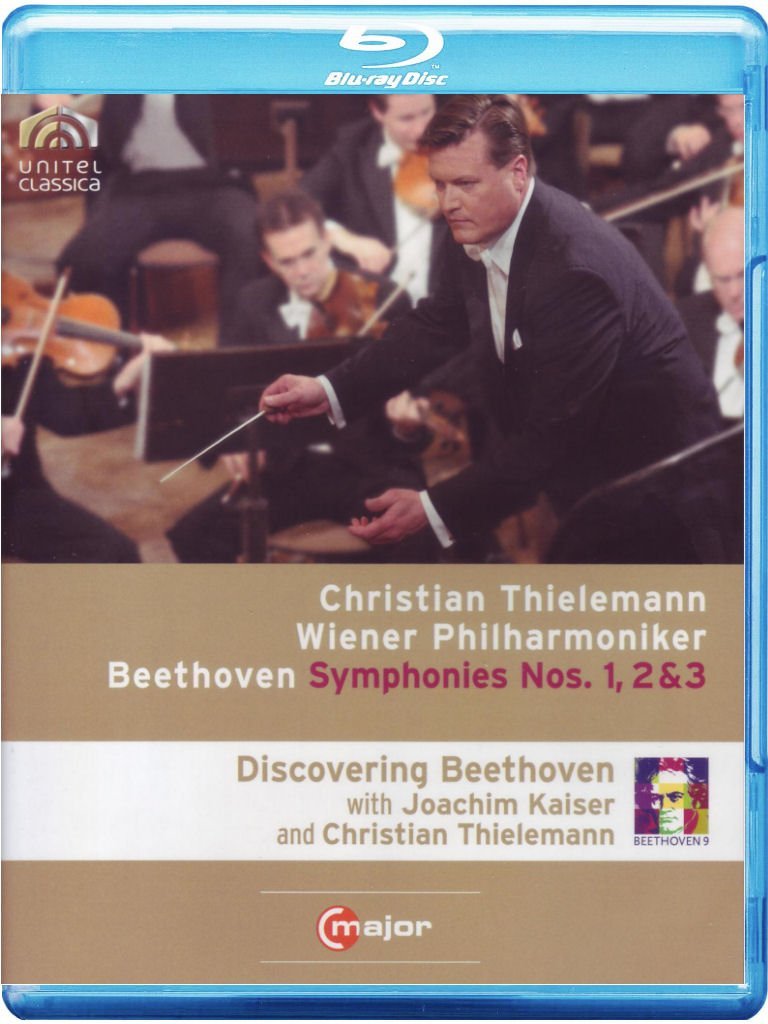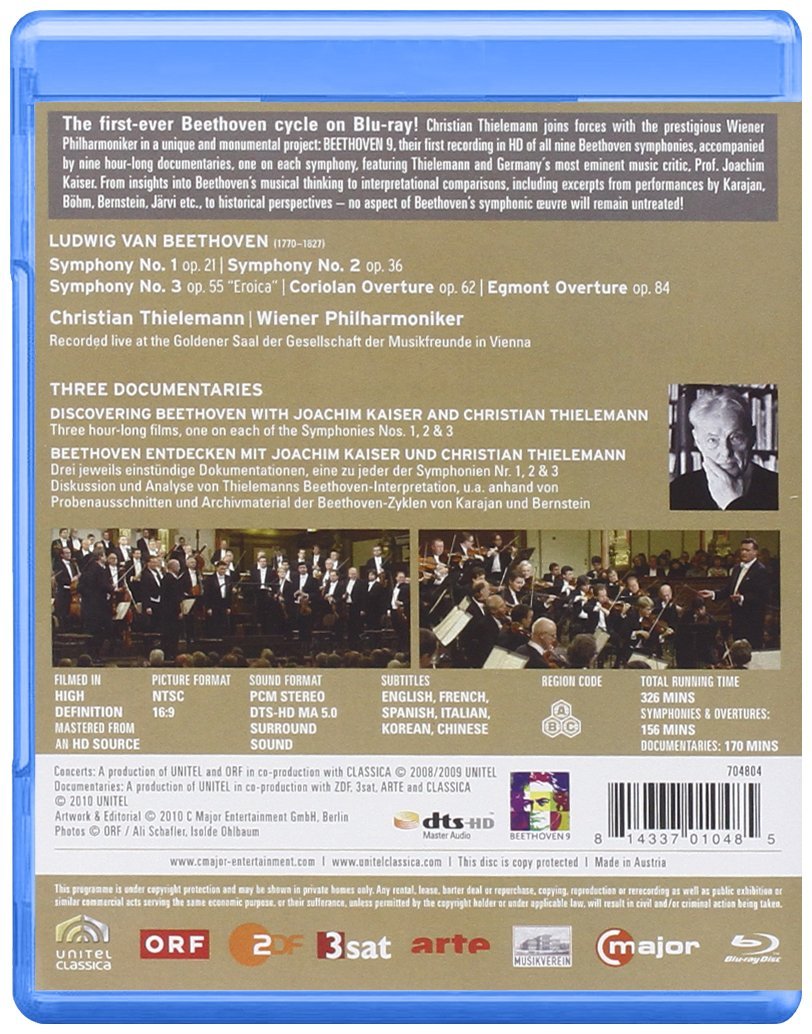

Beethoven Symphonies 1-3 concert. Christian Thielemann conducts the Wiener Philharmoniker in Symphonies 1-3, plus the Coriolan Overture and the Egmont Overture, for a total of 156 minutes of music. Brian Large was video director for Symphonies 1 & 2 and the Coriolan, all recorded in 2008. Agnes Méth was video director for Symphony 3 and the Egmont, both recorded in 2009.
Also comes with two Discovering Beethoven documentary films with conversations between Thielemann and music critic Joachim Kaiser. The documentary film Symphony No. 1 and Symphony No. 2 was made by Christoph Engel. The documentary film Symphony No. 3 was made by Anca-Monica Pandelea & Christoph Engel. Each documentary lasts for almost an hour for a total of 170 minutes.
The total running time for the music and documentaries is 326 minutes on one disc. Released 2010, disc has 5.0 dts-HD Master Audio for the music. Documentaries are in high-definition video with PCM stereo sound. Blended grade for 3 symphonies: B-
This title is the first in a set of three separate titles that will present all 9 Beethoven Symphonies + two overtures + 9 hours of commentary by Thielemann and music critic Joachim Kaiser. The recordings were made in live concerts from 2008 through 2010. This was an ambitious project: all of Beethoven's symphonies in high-definition video and lossless quality sound played in the world's most prestigious music venue by one of the best orchestra in the world led by one the the best conductors — all bolstered by documentary analysis!
Magisterial Thielemann set out to lead the Wiener Philharmoniker in series of concerts and recordings of historical importance. The musicians (you see considerable variation in forces required and personnel used) responded magnificently. There are hundreds, maybe thousands, of LPs, CDs, and DVDs of the Beethoven symphonies with many wonderful performances and interpretations by scores of famous conductors. There are many sets of all 9 symphonies. True music lovers will cherish their favorite finds. But how many of these legacies titles are available in lossless surround sound? The recordings in this set would likely all qualify for the "super audio corner" at Gramophone magazine, even if they would not be fully competitive with the best 96kHz/24bit orchestral recordings we have from NHK.
The picture quality of these recordings is good to very good. Symphonies 1 and 2 were shot by Brian Large, one of the best in the business. Large's handling of light level control, color reproduction, presence of video detail, field of focus, and video editing is completely satisfying. The light level in the Agnes Méth video of Symphony 3 is a bit too high for our taste, which seems to result in reduced video resolution.
But alas, there are serious reservations about the video content which will require us to reduce our grades from the A level that these titles might have earned otherwise. These downgrades will be the main subject of the individual reviews that follow.
We have written extensively on this site about the characteristics of a good HDVD of a symphonic work. A good HDVD follows Huang's law: "Use the flexible power of the the high-def camera to get a pleasant (not hyperactive) mixture of shots of the whole orchestra, groups of sections, large sections, small sections, groups of sections and individuals, and solo players — depending on what forces the composer commits at various places in the score." In other words, give the viewer as much visual information as possible (just like being there) and only go in for close-ups when there's a specific reason.
You can't follow Huang's law in a DVD. The low resolution of the DVD camera makes it difficult or impossible to get a decent image of a whole symphonic orchestra. This pretty much forces the DVD director to make a movie by stringing together a long series of close-ups of "easy targets." We call this a "road runner race" in honor of the Road Runner cartoons. If you shoot a great DVD, it will be a bad HDVD. If you shoot a great HDVD, it will not look good in DVD.
Beethoven Symphony No. 1
No video can be both a great DVD and a great HDVD. But the TV Director can try for a hybrid, and we think this is what Brian Large was attempting in 2008 (long ago) with his Symphony No. 1. We count 234 cuts here, which works out to be 7.2 seconds on average for each cut. That's slow for a DVD, but also about twice as fast as the state-of-the-art Schumann Piano Concerto HDVD from NHK, So we would call 7.2 seconds per cut a hybrid pace. To Large's everlasting credit, he includes 14 nice whole-orchestra views and 16 decent part-orchestra views. But we note these large-scale shots, which should last 10 to 30 seconds each in a good HDVD, tend here to last 4 to 7 seconds. So Large had the right idea, but he doesn't give you enough time to enjoy it. (If he gave more time, the folks watching the DVD version would become too aware of the rotten DVD resolution of the picture at such long range.)
Large also comes up with some mid-range shots that visually connect whole sections to the music they are making. See for example 06:25 to 06:41 for a long, beautiful shot of the whole 1st violin section taking and releasing the lead several times in an intricate and delicate passage with the other strings. This is the kind of state-of-the-art videography that HD cameras now make possible. We note also that Large's cameramen know how to follow the score and pan through heavy traffic without causing motion artifacts. Few seem to have the skill to do this.
But Large's take here has other features that he inherited from all those DVDs he has made. There are way too many conductor shots including 17 shots of Thielemann made over the backs of musicians, something we find inexcusable in HDVD. There are still a lot of shots of solos or tiny groups of musicians alternating with the conductor views. And then there are the 6 instrument-only views and 3 shots of the back of the head of string players.
We conclude that this show beats a DVD in PQ and the video content, but still falls short of what we should expect if a show is correctly shot solely for HDVD. Grade: B
Beethoven Symphony No. 2
The video content here, also from Brain Large, is very similar the Beethoven Symphony No. 2. Grade: B
Beethoven Symphony No. 3
Large produced hybrids for the first two symphonies; for Symphony No. 3, Agnes Méth comes up with video content that is pure DVD. It's hard to believe, but we have documented a count of no less than 612 cuts for Méth's No. 3 (vs. 234 cuts for the Large No. 1). True, No. 3 is considerably longer than the earlier symphonies. The average cut in No. 3 lasts 5.6 seconds (vs. 7.3 seconds for the Large No. 1 and 14.5 seconds for the NHK Schumann Piano Concerto.) Stated differently, this Méth recording has a pace almost 3 times as fast as Schumann Concerto that we regard as a model HDVD.
Let's not forget that the live spectator sees Symphony No. 3 in one cut. But with the Méth recording, the viewer has to deal with 612 video events in less than a hour. This is a huge overhead for the brain to process just to keep track of what is happening. How much energy is left to hear and enjoy the music? There are an astonishing 139 frames with just an instrument (sometimes a chin at the top.) Folks, once you have seen a picture of a clarinet fill a HDVD screen, you really never need to see it again. We know what a clarinet looks like, and we know what human hands look like. But these lazy, worthless shots are popular with DVD cameramen because they are easy to set up and hard to mess up. Following the standard DVD approach, there are 132 cuts just of the conductor, over half of of which are made over the backs of musicians. No conductor, not even the intelligent and expressive Thielemann, is that interesting. And we submit that the backs of musicians are even less interesting than a conductor.
True, Méth does sneak in 25 whole-orchestra shots. But they tend to be shorter than the average cut. There are a few part-orchestra views, but there is no attention given to larger sections except the bass violins that are easy shoot from the side all standing in a row like soldiers at attention.
Finally, Méth over-exposed the cameras for a slightly washed-out picture. The resolution is a bit soft compared to what I got used to in the Large videos.
We conclude Méth's S No. 3 suffers from a severe case of DVDitis and gets Grade: C.
OR
